Aardonyx Guide:
Aardonyx was an early dinosaur that lived in South Africa about 200 million years ago.
Aardonyx was an early dinosaur that lived in South Africa about 200 million years ago.
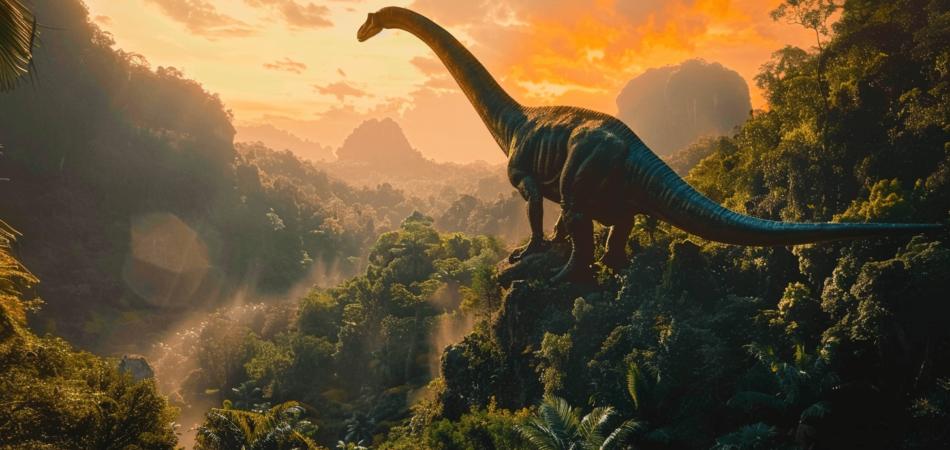
In the vast tapestry of prehistoric life, the Diplodocus looms large, both literally and figuratively. This behemoth, with its long neck stretching towards the sky and tail sweeping the ground, offers a glimpse into the grandeur of the Jurassic era.
Its life, set against the backdrop of the lush Morrison Formation, reveals a complex world where survival hinged on size, strength, and smarts. Yet, the Diplodocus wasn’t just another giant; its unique adaptations speak volumes about the evolutionary marvels of its time.
As we unearth the secrets of its existence, one can’t help but wonder what lessons this ancient creature holds for understanding the delicate balance of our planet’s ecosystems. The journey into its world is not just about uncovering the past; it’s about deciphering the whispers of the earth itself.
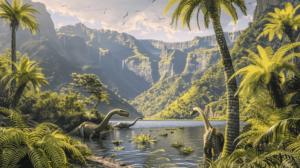
The Diplodocus, a colossal herbivore of the Late Jurassic period, thrived in what’s now North America, captivating scientists and enthusiasts alike with its long neck and uniquely flexible tail. This herbivorous dinosaur roamed the Earth approximately 161 to 146 million years ago, during a time when the continents were arranged differently than they’re today. Its existence in the fossil-rich terrains of the Morrison Formation, spanning across states like Wyoming, Utah, and Colorado, provides invaluable insights into the prehistoric ecosystems of the Late Jurassic period.
Diplodocus’s adaptation to its environment was remarkable. With its long neck, it could reach high and low vegetation, allowing it to feed efficiently in the diverse landscapes of North America. The dinosaur’s body was supported by pillar-like legs, a structural adaptation that enabled it to support its massive body while moving through the semi-arid landscapes it called home. This combination of physical characteristics not only highlights the Diplodocus’s ability to thrive in its environment but also underscores the evolutionary marvels of the Late Jurassic period.
Exploring the remarkable physical characteristics of Diplodocus further, it’s evident that this dinosaur’s anatomy was perfectly adapted for its lifestyle, from the long neck supporting at least 15 vertebrae to the specialized peg-like teeth for consuming vegetation. This sauropod’s long neck allowed it to access a wide range of foliage, making feeding both efficient and effective. The presence of at least 15 vertebrae in the neck was a distinctive feature, providing both flexibility and strength.
The peg-like teeth of Diplodocus, positioned at the front of its mouth, were specifically designed for stripping leaves off branches, not for chewing. These teeth highlight the dinosaur’s herbivorous diet, showcasing an evolutionary adaptation to its environment. Alongside these features, the tail of Diplodocus, adorned with keratinous spines, possibly served as a defensive mechanism against predators or perhaps played a role in intraspecific communication.
Fossil remains have also revealed the presence of scales of various shapes across the Diplodocus’ body, adding an intriguing layer to our understanding of its physical appearance. Furthermore, the relatively small skull in comparison to its massive body size stands out as a unique characteristic among sauropods, underscoring the remarkable diversity within this group of dinosaurs.
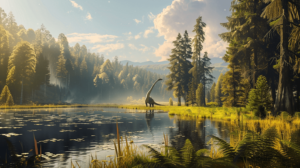
Diplodocus’ habitat, primarily within the bounds of the Morrison Formation’s semi-arid landscape, reveals much about the dinosaur’s daily life and the prehistoric ecosystems it thrived in. This area, stretching across parts of Wyoming, Utah, and Colorado, has provided a wealth of fossil finds. These discoveries have been pivotal in piecing together the distribution and living conditions of the Diplodocus during the Jurassic era.
The Morrison Formation’s climate was notably semi-arid, suggesting that Diplodocus adapted to relatively dry environments with occasional water sources. These riparian areas were crucial for the sustenance of Diplodocus and other contemporaneous species, offering a glimpse into the dynamics of ancient ecosystems.
Furthermore, the distribution of Diplodocus remains across various parts of North America underscores the wide range this dinosaur once had. It wasn’t confined to a single locale but spanned a significant portion of what’s today the American West.
Understanding the habitat and distribution of Diplodocus has allowed paleontologists to reconstruct the ancient landscapes of North America. It provides insights into the environmental conditions and geographical spread of this iconic dinosaur, deepening our appreciation of its role within prehistoric ecosystems.
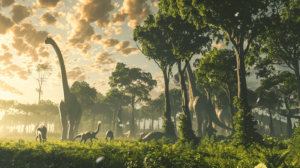
Understanding how Diplodocus thrived in its habitat leads us to explore what it ate and how its feeding behavior supported its massive size. As a herbivore, Diplodocus had a diet that mainly consisted of ferns, conifers, and cycads. It’s fascinating to think about how this giant creature, with its long neck and peg-like teeth, managed its daily intake to sustain its enormous body.
The Diplodocus’s feeding habits were quite remarkable. It likely practiced selective feeding, which means it didn’t just eat anything in its path. Instead, it used its long neck to reach higher vegetation and its peg-like teeth to strip leaves from branches. This method allowed Diplodocus to access the most nutritious parts of plants, optimizing its energy intake.
Moreover, the dinosaur’s digestive system was specially adapted to process large amounts of plant material efficiently. Given its size, Diplodocus needed to consume a substantial quantity of food daily. Studies suggest that despite its slow metabolism, the sheer volume of its intake was enough to support its weight and energy needs. This combination of selective feeding, a specialized digestive system, and a long neck for accessing a variety of plants, underscores the unique adaptations of Diplodocus in its environment.

Delving into the life cycle of Diplodocus reveals a fascinating journey from egg to towering giant, marked by unique reproductive strategies and communal nesting behaviors. Fossil evidence suggests that the Diplodocus, during its reproductive cycle, laid two eggs at a time, a modest number considering their enormous size. Despite this, each clutch likely contained about 25 eggs, indicating a strategy that balanced the energy demands of egg production with the survival needs of the offspring.
The nesting habits of these ancient giants remain largely enigmatic to scientists. However, it’s believed that Diplodocus, like other sauropods, nested communally. This behavior suggests a level of social cooperation and possibly even care for the young, which would have enhanced the survival rates of their offspring. The communal nesting might’ve served multiple purposes, including protection from predators and facilitating the learning of social behaviors essential for survival to sexual maturity.
Given the immense size of Diplodocus adults, the journey from hatchling to full-grown dinosaur was undoubtedly a long one, filled with challenges and milestones. Yet, the communal aspect of their early lives provided a crucial support system, underscoring the complex and intertwined nature of life cycles in the prehistoric world.
Exploring the evolutionary timeline, it’s clear that the appearance of advanced sauropod lineages like Diplodocus marks a significant moment in prehistoric history. This long-necked giant, a standout member of the Diplodocidae family, emerged from the rich fossil beds of the Morrison Formation, extending our understanding of the Jurassic era’s complexity. The first Diplodocus fossils, discovered in 1877 in Canyon City, Colorado, opened a window into a world where these colossal herbivores thrived.
Diplodocus’s evolution is a testament to the adaptability and diversity of sauropods. Advanced sauropods like Diplodocus appeared earlier in the evolutionary record than previously realized, suggesting a rapid diversification of this group. The notable Diplodocus specimens found in 1899 further cemented its significance in the paleontological community, offering insights into its unique physical characteristics and the challenges it faced during development and maturation.
The evolutionary journey of Diplodocus, from its first appearance to becoming a dominant figure in the Morrison Formation’s ecosystems, highlights the dynamic nature of evolution. It’s a saga of adaptation, survival, and the intricate web of life that once flourished in prehistoric landscapes.
In the complex ecosystem of the Late Jurassic period, Diplodocus not only competed with fellow herbivores like Camarasaurus and Brachiosaurus for food but also faced threats from predators such as Allosaurus. This competition for resources highlighted the intricate ecosystem dynamics that governed life during this era. The herbivorous giants, although massive and formidable in size, had to navigate a landscape where food was a precious commodity, requiring them to possibly engage in social interactions to ensure survival. Forming herds could have been a strategy not just for foraging efficiency but also as a defense mechanism against the looming threat of predation.
The presence of Diplodocus within this diverse web of life also played a significant role in shaping the biodiversity of their habitat. By feeding on tough vegetation, these colossal creatures could have influenced the distribution and types of plant life, thereby indirectly affecting the availability of resources for other species within the ecosystem. Their interactions, both competitive and cooperative, underline the interconnectedness of the Jurassic environment, showcasing a complex tapestry of life where each species, including Diplodocus, contributed to the overall ecosystem dynamics.
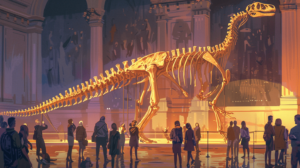
Beyond its pivotal role in the Jurassic ecosystem, Diplodocus has also seized the spotlight in cultural realms, captivating audiences around the globe with its grandeur and mystery. As one of the most commonly displayed dinosaurs in museums, it graces exhibits worldwide, standing as a testament to its enduring cultural significance. These paleontological displays often feature Diplodocus alongside other iconic sauropods like Apatosaurus, drawing crowds eager to gaze upon these prehistoric giants.
The fascination with Diplodocus extends beyond museum walls; it’s a frequent star in movies, documentaries, and educational programs, weaving its way into the fabric of popular culture. Its appearances in blockbuster films such as ‘Jurassic Park’ and ‘Jurassic World’ have cemented its status as a symbol of the Late Jurassic Period, sparking awe and fascination across generations. This broad cultural impact underscores the dinosaur’s appeal, transcending scientific interest to become a beloved icon.
Diplodocus’s unique features and immense size not only illuminate the dynamics of its ancient habitats but also continue to inspire curiosity and wonder, ensuring its place in the pantheon of prehistoric marvels with an enduring legacy that captivates people of all ages.
As the sun sets on our journey through the ancient world of the Diplodocus, we’re left pondering the mysteries that still shroud this majestic creature.
Even with the wealth of knowledge unearthed, countless questions linger, teasing the minds of scientists and enthusiasts alike.
What untold stories lie buried beneath the earth, waiting to redefine our understanding?
The Diplodocus’s legacy, both colossal in size and in impact, continues to challenge and inspire, promising that this isn’t the end, but merely the beginning of an ever-evolving tale.